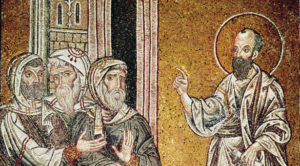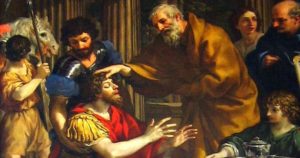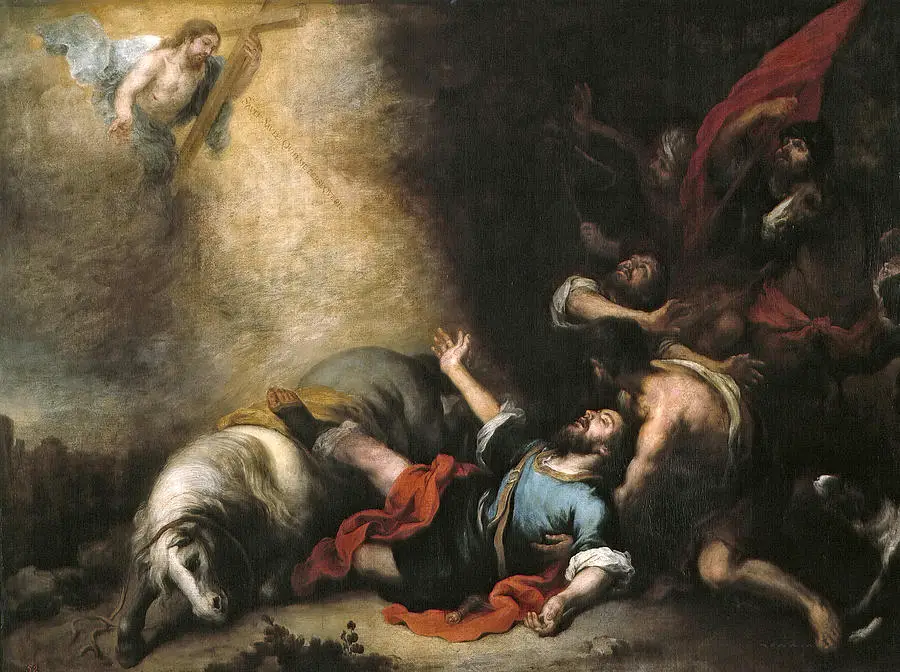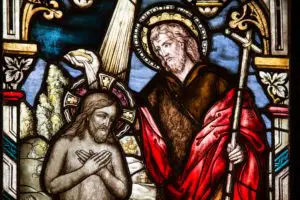One of the most dramatic events in Luke’s historical account of the birth and development of the early Church is Saul of Tarsus’ conversion from Christian persecutor to Christ follower. Jesus appeared to Saul on the road to Damascus as the zealous Pharisee was en route, having been given authority by the high priest to arrest Christians and bring them back to Jerusalem to be punished.[1]
How did Saul’s view of Jesus change after he encountered the resurrected and exalted king? Did he realize that not only was Jesus the promised Messiah, he was also the God of the universe? What revelation did Jesus give about himself that forged Saul’s understanding and transformed him into Paul, the first century’s greatest missionary?[2] We’ll answer these questions and more by examining Paul’s road to Damascus experience. Let’s begin by exploring Paul’s theology prior to his encounter with the Lord.
Saul of Tarsus’ Theology
Much of what we know about Saul prior to his encounter with Jesus comes from Saul’s own words. He said he was “a Jew, born in Tarsus of Cilicia,” and therefore, “born a citizen of Rome.”[3] He received his strict rabbinic training from Gamaliel, a respected rabbi and member of the Sanhedrin.[4] Saul said on more than one occasion, that he was “zealous for the law,” and “for God,” and for “his ancestral traditions.”[5] What then would this self-described “Hebrew of Hebrews” who was “blameless” according to the Law[6] have believed about who God is? According to Saul, he believed everything the Scriptures had to say:
Acts 24:14 (NASB) “But this I admit to you, that according to the Way which they call a sect I do serve the God of our fathers, believing everything that is in accordance with the Law and that is written in the Prophets (emphasis added)
Thus, Paul’s beliefs would have included adherence to the Jewish creed known as the Shema.[7] This Biblical statement of faith says that God is one:
Deuteronomy 6:4-5 (NASB) “Hear, O Israel! The LORD [Yahweh] is our God, the LORD [Yahweh] is one! 5 “You shall love the LORD your God with all your heart and with all your soul and with all your might. (emphasis added)
What’s more, Paul would have believed, based on Scripture, that the coming Messiah was a servant of God[8] destined to rule on God’s behalf as the prophet Micah records.[9] The persecutor turned apostle would not have believed, nor would any traditional Torah-keeping Jew of his day, that the Messiah was himself, Almighty God as this would have been antithetical to the one God of the Shema. In other words, before Paul encountered Jesus on the road to Damascus, there was no Scriptural-based concept whatsoever that this singular God was instead a member of a tri-person Godhead. Nor could he have conceived that the Messiah was co-equal, co-eternal, or con-substantial with God the Father as fourth century creeds would later determine. Who then did Saul believe Jesus to be?

Who Did Saul Believe Jesus to Be?
Saul did not believe the man from Nazareth was the promised Messiah. On the contrary, he believed him to be an imposter, as evidenced by his zeal to destroy those who followed this “false” Christ. Luke tells us that Saul was in “hearty agreement” when the Sanhedrin stoned Stephen to death for accusing the council of murdering the Righteous One, that is, the Messiah.[10] Saul was so enraged against those who professed Jesus to be the Christ that he “began ravaging the church, entering house after house, and dragging off men and women, he would put them in prison.”[11] Nevertheless, Saul’s persecutory zeal wasn’t satisfied. He asked for authority to pursue Christ-followers beyond the gates of the holy city:
Acts 9:1-6 (NASB) Now Saul, still breathing threats and murder against the disciples of the Lord, went to the high priest, 2 and asked for letters from him to the synagogues at Damascus, so that if he found any belonging to the Way, both men and women, he might bring them bound to Jerusalem. 3 As he was traveling, it happened that he was approaching Damascus, and suddenly a light from heaven flashed around him; 4 and he fell to the ground and heard a voice saying to him, “Saul, Saul, why are you persecuting Me?” 5 And he said, “Who are You, Lord?” And He said, “I am Jesus whom you are persecuting, 6 but get up and enter the city, and it will be told you what you must do.” (emphasis added)
Saul pointedly asked, “Who are you, Lord?” creating the perfect opportunity for Jesus to reveal that he is God, the second member of the Trinity. But Jesus said nothing whatsoever to alter Saul’s understanding that he was a man who was crucified for claiming to be the Messiah.
Saul, blinded by the heavenly light, was led into the city where he spent three days fasting and praying until a disciple named Ananias, instructed by the risen Lord, came to him with a message:[12]
Acts 9:17-22 (NASB) So Ananias departed and entered the house, and after laying his hands on him said, “Brother Saul, the Lord Jesus, who appeared to you on the road by which you were coming, has sent me so that you may regain your sight and be filled with the Holy Spirit.” 18 And immediately there fell from his eyes something like scales, and he regained his sight, and he got up and was baptized; 19 and he took food and was strengthened. Now for several days he was with the disciples who were at Damascus, 20 and immediately he began to proclaim Jesus in the synagogues, saying, “He is the Son of God.” 21 All those hearing him continued to be amazed, and were saying, “Is this not he who in Jerusalem destroyed those who called on this name, and who had come here for the purpose of bringing them bound before the chief priests?” 22 But Saul kept increasing in strength and confounding the Jews who lived at Damascus by proving that this Jesus is the Christ. (emphasis added)
Here Luke provides the reader with additional details as to Saul’s encounter with the Lord. He records that Saul now understands this man from Nazareth, whom he believed to be a charlatan, is truly the Messiah, as evidenced by the message Saul began to preach in the synagogues. Saul, now filled with the Holy Spirit, began to proclaim Jesus to be the Son of God, a term the first century Jews used synonymously with the Messiah.[13] This is confirmed when Luke writes in verse 20 that Saul confounded the Jews by proving that Jesus is the Christ.

The question before us is, did Paul’s theology change once Jesus revealed himself to the Pharisee from Tarsus? The answer is a resounding no! At no time is Saul given any information to counter his Scriptural understanding that God is one person. Jesus never told Saul that he is God. Instead, what changed was his Christology. Saul now understands that Jesus truly is the promised king, and this is precisely what he begins to preach. The one who once persecuted followers of Jesus was now preaching faith in him as the Christ:
Galatians 1:22-23 (NASB) I was still unknown by sight to the churches of Judea which were in Christ; 23 but only, they kept hearing, “He who once persecuted us is now preaching the faith which he once tried to destroy.” (emphasis added)
That Saul’s encounter with the risen Jesus only revealed that the man from Nazareth was the promised Christ is further corroborated by his retelling of these events. When he appeared before a hostile crowd in Jerusalem, Saul declared:
Acts 22:1-8 (NASB) “Brethren and fathers, hear my defense which I now offer to you.” 2 And when they heard that he was addressing them in the Hebrew dialect, they became even more quiet; and he *said, 3 “I am a Jew, born in Tarsus of Cilicia, but brought up in this city, educated under Gamaliel, strictly according to the law of our fathers, being zealous for God just as you all are today. 4 “I persecuted this Way to the death, binding and putting both men and women into prisons, 5 as also the high priest and all the Council of the elders can testify. From them I also received letters to the brethren, and started off for Damascus in order to bring even those who were there to Jerusalem as prisoners to be punished. 6 “But it happened that as I was on my way, approaching Damascus about noontime, a very bright light suddenly flashed from heaven all around me, 7 and I fell to the ground and heard a voice saying to me, ‘Saul, Saul, why are you persecuting Me?’ 8 “And I answered, ‘Who are You, Lord?’ And He said to me, ‘I am Jesus the Nazarene, whom you are persecuting.’ (emphasis added)
Jesus did not identify himself as God or the Pre-Incarnate Word who pre-existed in heaven but simply as the one who is from Nazareth. Moreover, in this account, we are given additional information about what Ananias told Saul:
Acts 22:12–16 (NASB) “A certain Ananias, a man who was devout by the standard of the Law, and well spoken of by all the Jews who lived there, 13 came to me, and standing near said to me, ‘Brother Saul, receive your sight!’ And at that very time I looked up at him. 14 “And he said, ‘The God of our fathers has appointed you to know His will and to see the Righteous One and to hear an utterance from His mouth. 15 ‘For you will be a witness for Him to all men of what you have seen and heard. 16 ‘Now why do you delay? Get up and be baptized, and wash away your sins, calling on His name.’ (emphasis added)
Ananias identifies God as the “God of our fathers,” while Jesus is placed into a different category, that of the “Righteous One,” a designation for the Messiah. [14] In other words, Ananias did not say that the God of our fathers had determined that Saul would see and hear from God, but that he would see and hear from the Christ.

Some might reason that the spectacular manner in which Jesus appeared to Saul demonstrates he is God. This is not the case, however, as angels have appeared to New Testaments saints in a similar fashion. Surely, no one would argue that this proves they are deity.[15] Rather, it was the exalted Jesus, now glorified and raised to immortality that Saul encountered.
If Jesus is God, we would reasonably expect this monumental encounter on the road to Damascus to include a revelation that Jesus is not only the Messiah but also God Almighty, a revelation that far exceeds that of the Messiah in relevance and importance. But somehow, this fundamental doctrine is omitted. Not only is it absent in this life-changing encounter, but it is also absent from the rest of the book of Acts. What’s more, contrary to what orthodoxy purports, Paul never taught it in his epistles even though he said he “preached the whole counsel of God.”[16] Indeed, the apostle’s summary teaching on who God is can be found in his letter to the church at Corinth:
1 Corinthians 8:5-6 (NASB) For even if there are so-called gods whether in heaven or on earth, as indeed there are many gods and many lords, 6 yet for us there is but one God, the Father, from whom are all things and we exist for Him; and one Lord, Jesus Christ, by whom are all things, and we exist through Him. (emphasis added)
Paul succinctly and cogently teaches that God the Father is the one God, in keeping with the Shema of Deuteronomy 6:4. On the other hand, Paul writes that Jesus is the Christ, which is in keeping with the revelation given to him on the Damascus road. Where then did the idea that Paul believed Jesus is God originate? The historical record shows that this post-Biblical doctrine took over three hundred years to fully develop, and it wasn’t codified as official Church dogma until the Council of Nicaea in 325 AD.
Saul of Tarsus rightly chose to abandon what he wrongly believed about Jesus in order to embrace the truth about who he is. Likewise, we must decide whether or not to believe the revelation the risen Lord gave to Saul on his way to Damascus–that he is the Christ–or if we will cling to the beliefs that have been handed down to us by the Hellenized Catholic Church Fathers.
[2] I use the names, Saul and Paul, interchangeably throughout this article. See Acts 13:9.
[4] Acts 22:3 and Acts 5:34-35.
[5] Acts 21:20; 22:3; Galatians 1:14.
[7] Shema or shama is the Hebrew word for listen or hear, which is the first word in the creed.
[8] Isaiah 42:1-7; 49:3-13; 50:10; 52:13-15; 53:11-12; Zechariah 3:8; Psalm 2:6; Acts 3:13; 4:24, 26-28 and 30, etc.
[13] John 1:49; 20:31; Luke 4:41; Matthew 16:16; 26:63, etc.
[14] Righteous One is a reference to the Messiah in Isaiah 53:11. It is not a reference that is reserved for deity as seen in Hebrews 10:38 when God refers to those who do His will as His righteous one.
[15] Luke 2:9-13; 24:4; Acts 12:7, etc.
[16] Acts 20:27. The emphasis in Paul’s letters is that Jesus is the Christ of God, crucified for our sins, and raised from the dead. It was this Jesus that appeared to him on the road to Damascus. See 1 Corinthians 15:3-19, etc.



